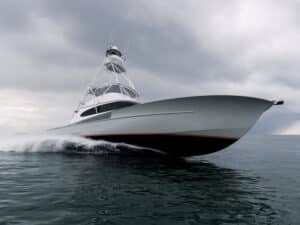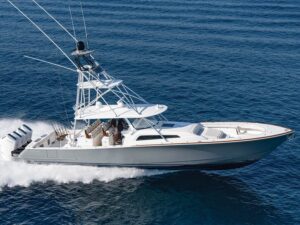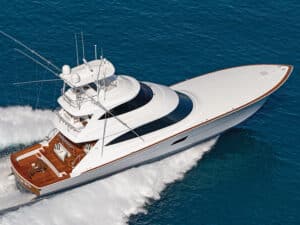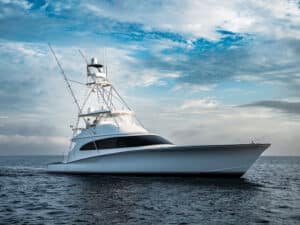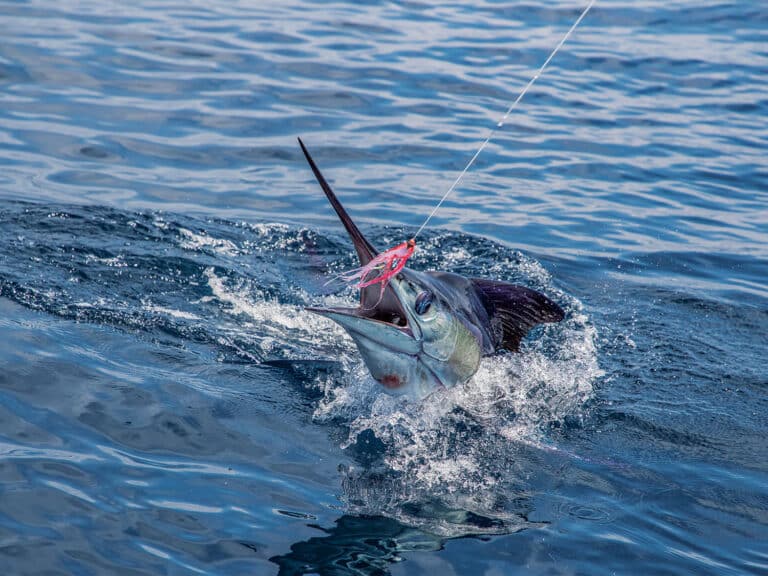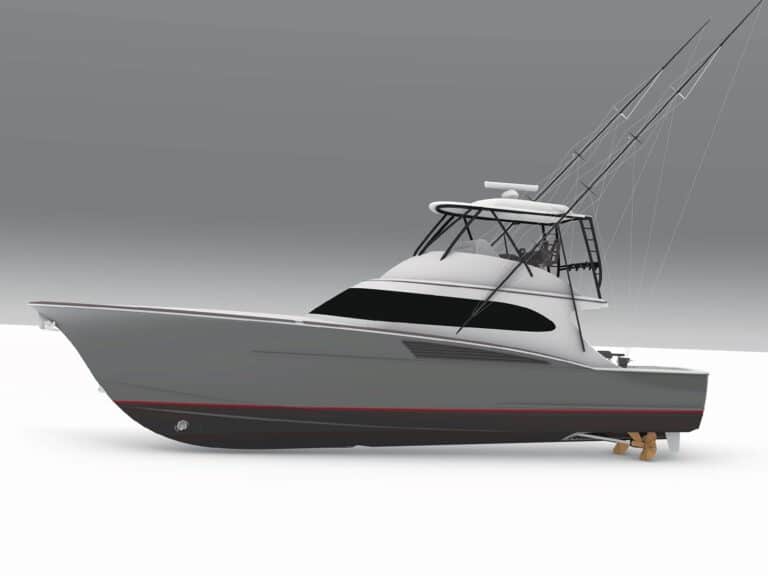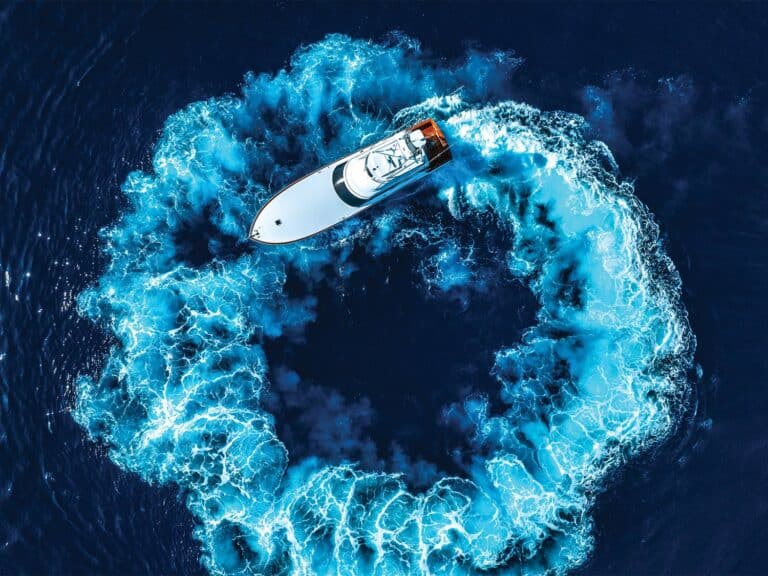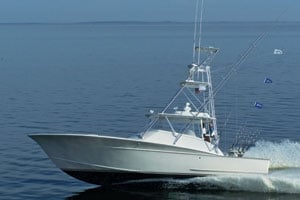
One thing in particular impressed me greatly when I visited Spencer’s yard in Wanchese, North Carolina: In a time when most every other boatbuilder has cut staff and is praying to make it through the recession, Spencer has a dozen boats in process and the yard is crawling with workers. In every bay, I saw a boat under construction. That speaks volumes about the quality and popularity of this builder. I attribute this to several things: Spencer builds top-quality boats as plain or as fancy as you want, but all are undeniably seaworthy and beautiful. And Paul Spencer isn’t afraid to take some chances in his quest for improvement.
The Spencer 43 holds the notoriety of being the first dedicated custom fishing boat to install Volvo Penta’s IPS (Innovative Propulsion System) drives: the pods that hang straight down from the hull with dual, counter-rotating propellers facing forward. Yes, you could call boaters and fishermen “change averse,” and yes, I expect acceptance of this revolutionary (and odd-looking) running gear to come slowly. But it is the proverbial “better mousetrap,” and once you run a boat with pods, you won’t rest until you get one.
Admittedly, the majority of boats equipped with Volvo Penta’s IPS are cruisers. These boats benefit from IPS because in addition to the dramatic improvement in all aspects of performance and handling this system offers up, it also accounts for a measurable increase in usable space belowdecks. In fact, most boats can actually add an entire double cabin when using IPS drives.
Performance
Volvo calls its 435 hp diesels IPS 600s – only they know why. The engines mount beneath the cockpit sole and attach directly to the pods protruding through the hull bottom. Computer software controls each pod independently for optimum maneuverability. In addition to the standard single-lever shifters, IPS provides a joystick for close-quarters maneuvering. With the joystick, you can move the boat in any direction you wish – sideways, diagonally, pivoting, forward and backward – all with the nudge of the stick. Single-lever controls connect to the electronic shifting and throttle mechanisms to control the engines.
These engines perform superbly with or without the IPS system. Equipped with both a supercharger and turbocharger, the IPS 600s react to throttles more like big-block gas V-8s than diesels. The supercharger kicks in at low rpm for instant response and torque – you don’t have to wait for the turbocharger to build boost pressure. Once the turbo hits its peak, the supercharger drops out for high-end response.
Trolling at 3.9 knots burned less than 1 gph and resulted in a very clean wake with virtually no engine noise or exhaust – again thanks to the IPS. (Exhaust comes out the pod below the waterline.)
At cruising speed the 43 reverses course in less than three boat lengths, but Volvo’s speed-sensitive turning requires you to pull back on the throttles a tad if you want a tighter turning radius. IPS software dictates that turns at higher speeds scribe wider arcs – all part of the safety features built into the system.
Winds blowing out of the southeast at 18 to 20 knots and two-foot seas in the bay made for a real washboard ride. By adding a touch of trim tab to drop the nose, I got the Spencer 43 to slice through the slop with impunity.
After setting the 43 beam-to the weather, I easily walked it directly up-sea/upwind sideways using the joystick steering. Honestly, there’s nothing you can’t make this boat do with that joystick.
And then there’s “Sport Fish Mode!” Certainly more onboard room counts as a positive on any boat, but the true benefit to a fishing boat shows clearly when actually fighting a fish. Push the appropriate button on the control binnacle and the steering wheel locks while the pods tilt outboard. Then, just start maneuvering with your shifts and throttles. And don’t worry about slamming them from forward to reverse suddenly, either. The system won’t let you damage the gears. I honestly don’t believe there’s a fish in the sea that can outmaneuver Sport Fish Mode; however, I’d be willing to bet that few anglers will be able to reel fast enough to take up the slack when this boat churns and burns!
Other interesting performance aspects that set the Spencer apart include the ability to steer a straight line with one engine as easily as with two.
Layout
Most expresses feature centerline stairs from the cockpit to the bridge deck – which are just fine if nobody’s in the way when you need to reach the rail in a hurry. Spencer puts modules across the middle of the boat and stairs up both sides, so you’ll always have at least one clear avenue. You can access the engine compartment through day hatches in each stairway or by raising the entire bridge deck on worm gears. Either way, you can access all routine maintenance points with ease.
Spencer uses all LED lighting, with many that are multicolored and change hue at the touch of the on/off switch. Another interesting touch finds that every wire in the console (and elsewhere) has a barcode tag for quick and easy identification.
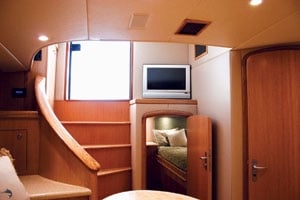
Spencer cold-molds its 43-foot hulls, building the stringers of composite foam and the hardtops out of carbon fiber. As you climb to the tower, the construction ingredients get lighter (without sacrificing strength) for an optimum center of gravity.
I won’t go into all the spaces Spencer dedicates to storage. Suffice it to say that Paul Spencer feels any dead space at all just isn’t prudent.
A semicircular stairway leads belowdecks, and while it’s attractive, it might be difficult to negotiate with offshore fishing rods should you choose to store them below.
I always look for (and rarely find) emergency exits on boats. Sure, many boats offer overhead hatches in the fo’c’sle but usually none anywhere else – especially not in the increasingly common midship cabins. The Spencer 43 puts an escape hatch behind the headboard in the starboard-side, mid-cabin berth. It allows you to escape the cabin rapidly should the need ever arise and provides an ideal route for passing rods belowdecks without scratching the exotic Anagray wood found throughout the salon. Anagray offers the light tones of ash but with a far more interesting grain pattern. Considered an exotic African wood, Anagray costs less than other, more endangered species such as mahogany and teak.
Notable interior features include the obligatory island double berth forward on centerline with steps up on both sides and – thanks to IPS – a midship guest cabin with a pair of full-size twin berths. Personally, I found this cabin even more comfortable than the master in the bow when under way – I’d always rather nap farther aft than in the bow.
This boat boasts one other unusual feature in the cockpit. Rather than having dedicated space for livewells or tuna tubes, Spencer installs plug-in capability for portable models of both equipment systems. If you don’t need them for all your fishing applications, take them out and don’t waste the space.
The gunwales stretch to “big-boat height” off the water’s surface, so you won’t find it as easy to revive a fish as you would on a smaller boat. However, from a fishing standpoint, the covering board met my leg just above the knee for optimum comfort and security without infringing on rod work. In addition, Spencer makes certain that you have enough room for your toes under the gunwales so that you’ll never feel like you’re being tipped over the side while fighting a fish.
I truly appreciate the elegance of this boat’s simplicity. Spencer proves time and again that he’s capable of meeting any boat owner’s demands, from totally over-the-top to exceedingly simple. However, in my humble opinion, doing simple work as well as Spencer does takes a much greater talent and skill.
LOA……43’3″
**BEAM……14’4″
DRAFT……3’2″
DEADRISE……12.5 degrees (at transom)
WEIGHT……29,572 pounds
FUEL……660 gallons
WATER……50 gallons
POWER……T Volvo 435 hp IPS 600 diesels
MSRP……$1,250,000**
Spencer Yachts / Wanchese, North Carolina / 252-473-6567 / www.spenceryachtsinc.com
